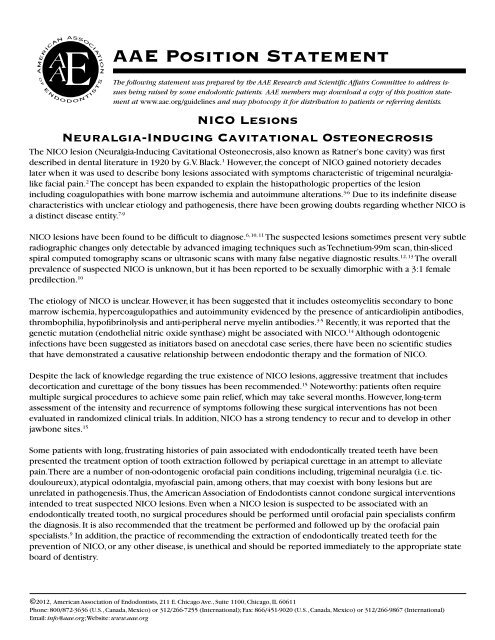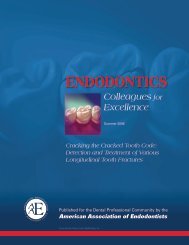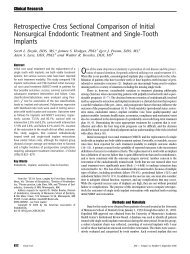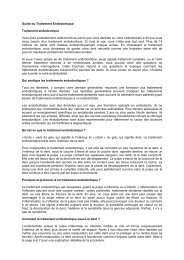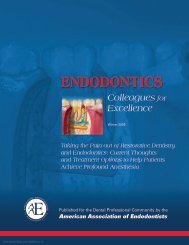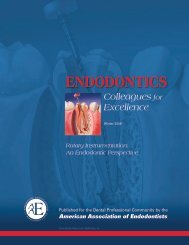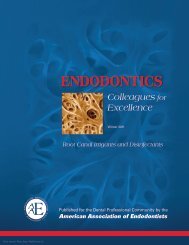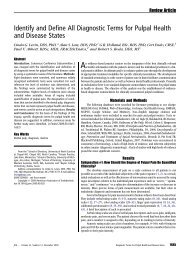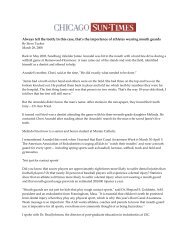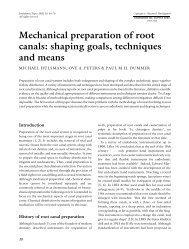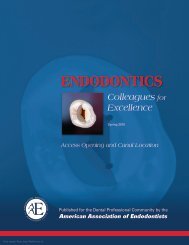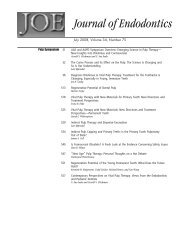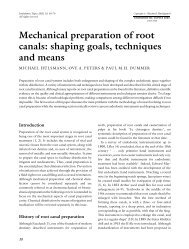NICO (Neuralgia-Inducing Cavitational Osteonecrosis) - American ...
NICO (Neuralgia-Inducing Cavitational Osteonecrosis) - American ...
NICO (Neuralgia-Inducing Cavitational Osteonecrosis) - American ...
Create successful ePaper yourself
Turn your PDF publications into a flip-book with our unique Google optimized e-Paper software.
AAE Position Statement<br />
The following statement was prepared by the AAE Research and Scientific Affairs Committee to address issues<br />
being raised by some endodontic patients. AAE members may download a copy of this position statement<br />
at www.aae.org/guidelines and may photocopy it for distribution to patients or referring dentists.<br />
<strong>NICO</strong> Lesions<br />
<strong>Neuralgia</strong>-<strong>Inducing</strong> <strong>Cavitational</strong> <strong>Osteonecrosis</strong><br />
The <strong>NICO</strong> lesion (<strong>Neuralgia</strong>-<strong>Inducing</strong> <strong>Cavitational</strong> <strong>Osteonecrosis</strong>, also known as Ratner’s bone cavity) was first<br />
described in dental literature in 1920 by G.V. Black. 1 However, the concept of <strong>NICO</strong> gained notoriety decades<br />
later when it was used to describe bony lesions associated with symptoms characteristic of trigeminal neuralgialike<br />
facial pain. 2 The concept has been expanded to explain the histopathologic properties of the lesion<br />
including coagulopathies with bone marrow ischemia and autoimmune alterations. 3-6 Due to its indefinite disease<br />
characteristics with unclear etiology and pathogenesis, there have been growing doubts regarding whether <strong>NICO</strong> is<br />
a distinct disease entity. 7-9<br />
<strong>NICO</strong> lesions have been found to be difficult to diagnose. 6, 10, 11 The suspected lesions sometimes present very subtle<br />
radiographic changes only detectable by advanced imaging techniques such as Technetium-99m scan, thin-sliced<br />
spiral computed tomography scans or ultrasonic scans with many false negative diagnostic results. 12, 13 The overall<br />
prevalence of suspected <strong>NICO</strong> is unknown, but it has been reported to be sexually dimorphic with a 3:1 female<br />
predilection. 10<br />
The etiology of <strong>NICO</strong> is unclear. However, it has been suggested that it includes osteomyelitis secondary to bone<br />
marrow ischemia, hypercoagulopathies and autoimmunity evidenced by the presence of anticardiolipin antibodies,<br />
thrombophilia, hypofibrinolysis and anti-peripheral nerve myelin antibodies. 3-5 Recently, it was reported that the<br />
genetic mutation (endothelial nitric oxide synthase) might be associated with <strong>NICO</strong>. 14 Although odontogenic<br />
infections have been suggested as initiators based on anecdotal case series, there have been no scientific studies<br />
that have demonstrated a causative relationship between endodontic therapy and the formation of <strong>NICO</strong>.<br />
Despite the lack of knowledge regarding the true existence of <strong>NICO</strong> lesions, aggressive treatment that includes<br />
decortication and curettage of the bony tissues has been recommended. 15 Noteworthy: patients often require<br />
multiple surgical procedures to achieve some pain relief, which may take several months. However, long-term<br />
assessment of the intensity and recurrence of symptoms following these surgical interventions has not been<br />
evaluated in randomized clinical trials. In addition, <strong>NICO</strong> has a strong tendency to recur and to develop in other<br />
jawbone sites. 15<br />
Some patients with long, frustrating histories of pain associated with endodontically treated teeth have been<br />
presented the treatment option of tooth extraction followed by periapical curettage in an attempt to alleviate<br />
pain. There are a number of non-odontogenic orofacial pain conditions including, trigeminal neuralgia (i.e. ticdouloureux),<br />
atypical odontalgia, myofascial pain, among others, that may coexist with bony lesions but are<br />
unrelated in pathogenesis. Thus, the <strong>American</strong> Association of Endodontists cannot condone surgical interventions<br />
intended to treat suspected <strong>NICO</strong> lesions. Even when a <strong>NICO</strong> lesion is suspected to be associated with an<br />
endodontically treated tooth, no surgical procedures should be performed until orofacial pain specialists confirm<br />
the diagnosis. It is also recommended that the treatment be performed and followed up by the orofacial pain<br />
specialists. 9 In addition, the practice of recommending the extraction of endodontically treated teeth for the<br />
prevention of <strong>NICO</strong>, or any other disease, is unethical and should be reported immediately to the appropriate state<br />
board of dentistry.<br />
©2012, <strong>American</strong> Association of Endodontists, 211 E. Chicago Ave., Suite 1100, Chicago, IL 60611<br />
Phone: 800/872-3636 (U.S., Canada, Mexico) or 312/266-7255 (International); Fax: 866/451-9020 (U.S., Canada, Mexico) or 312/266-9867 (International)<br />
Email: info@aae.org; Website: www.aae.org
References<br />
1. Bouquot JE. G.V. Black’s forgotten disease: <strong>NICO</strong> (neuralgia-inducing cavitational osteonecrosis). The<br />
Maxillofacial Center: Morgantown, West Virginia, 1994<br />
2. Bouquot JE, Roberts AM, Person P, Christian J. <strong>Neuralgia</strong>-inducing cavitational osteonecrosis (<strong>NICO</strong>).<br />
Osteomyelitis in 224 jawbone samples from patients with facial neuralgia. Oral Surg Oral Med Oral<br />
Pathol. 1992;73:307-19<br />
3. Glueck CJ, McMahon RE, Bouqout J, et al. Thrombophilia, hypofibrinolysis, and alveolar osteonecrosis of<br />
the jaws. Oral Surg Oral Med Oral Pathol Oral Radiol Endod 1996;81:557-66.<br />
4. Gruppo R, Glueck CJ, McMahon RE, et al. The pathophysiology of alveolar osteonecrosis of the jaw:<br />
anticardiolipin antibodies, thrombophilia, and hypofibrinolysis. J Lab Clin Med 1996;127:481-88.<br />
5. McMahon R, Boqout J, Mahan P, Saxen M. Elevated antimyelin antibodies in patients with maxillofacial<br />
osteonecrosis (<strong>NICO</strong>). J Oral Pathol Med 1998;27:345-46.<br />
6. Boqout JE, McMahon RE. Neuropathic pain in maxillofacial osteonecrosis. J Oral Maxillfac Surg<br />
2000;58:1003-20.<br />
7. Zuniga JR. Challenging the neuralgia-inducing cavitational osteonecrosis concept. J Oral Maxillofac Surg<br />
2000;58:1021-28.<br />
8. Sciubba JJ. <strong>Neuralgia</strong>-inducing cavitational osteonecrosis: a status report. Oral Dis 2009;15:309-12.<br />
9. Klasser GD, Epstein JB. <strong>Neuralgia</strong>-inducing cavitational osteonecrosis: a possible diagnosis for an<br />
orofacial pain complaint? J Am Dent Assoc. 2011;142:651-3<br />
10. Ratner EJ, Langer B, Evins ML.Alveolar cavitational osteopathosis. Manifestations of an infectious process<br />
and its implication in the causation of chronic pain. J Periodontol 1986;57:593–603.<br />
11. Segall RO, del Rio CE. <strong>Cavitational</strong> bone defect: a diagnostic challenge. J Endod 1991;17:396–400.<br />
12. Bouqout JE, Adams W, Spolnick K, Deardorf K. Technetium-99 m MDP (tech99) radioisotope scans and<br />
bone biopsies in 56 patients with chronic facial pain (abstract). Oral Surg Oral Med Oral Pathol Oral<br />
Radiol Endod 2001;92:543.<br />
13. Bouquot JE, Spolnik K, Adams W, Deardorf K. Technetium-99mTc MDP imaging of 293 quadrants of<br />
idiopathic facial pain: 79% show increased radioisotope uptake. Oral Surg Oral Med Oral Pathol Oral<br />
Radiol. 2012;114:83-92.<br />
14. Glueck CJ, McMahon RE, Bouquot JE, Khan NA, Wang P. T-786C polymorphism of the endothelial nitric<br />
oxide synthase gene and neuralgia-inducing cavitational osteonecrosis of the jaws. Oral Surg Oral Med<br />
Oral Pathol Oral Radiol Endod 2010;109:548-53.<br />
15. Bouquot JE, Christian J. Long-term effects of jawbone curettage on the pain of facial neuralgia. J Oral<br />
Maxillofac Surg 1995;53:387–97.<br />
AAE Position Statement on <strong>NICO</strong> Lesions (<strong>Neuralgia</strong>-Induced <strong>Cavitational</strong> <strong>Osteonecrosis</strong> 2


